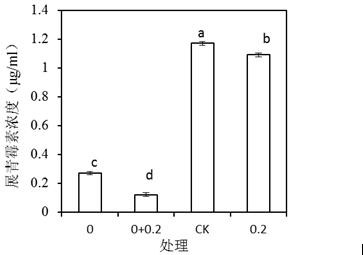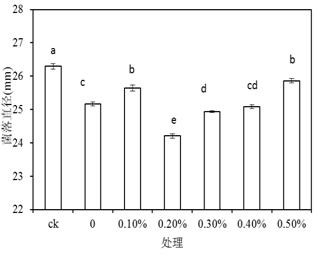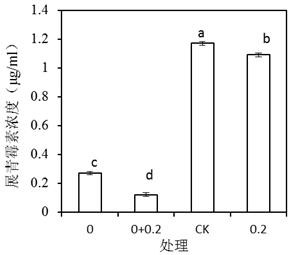Method for controlling apple patulin
A technology for patulin and apples, which is applied in the field of controlling apple patulin, and achieves significant economic and social benefits, simple method of use, and low cost
- Summary
- Abstract
- Description
- Claims
- Application Information
AI Technical Summary
Problems solved by technology
Method used
Image
Examples
Embodiment 1
[0025] Embodiment 1: the control of phytic acid combined with Rhodotorula gelatin to apple wound patulin
[0026] 1. Test plan
[0027] After fruit treatment, wounds of uniform size and depth were formed on the equator of each fruit surface with a sterilized puncher, and 30 μl of the following treatment solution was added to each wound in equal amounts: (1) 1×10 8 cells / ml of yeast (containing 0.2 % PA); (2) 1×10 8 cells / ml yeast; (3) PA (0.2%); (4) sterile water. After treatment, the fruits were placed in plastic baskets, sealed with plastic wrap, and stored at 25°C. After 3 hours, add an equal amount of 30 μl 5 × 10 4 spores / ml P. expansum spore suspension. After natural drying, the fruits were put into plastic baskets and sealed with plastic wrap, and cultivated in a constant temperature and humidity incubator (25°C, RH 95%). Each treatment was replicated 3 times, and each replicated 12 fruits.
[0028] Sample extraction and purification: apples were used as sample...
Embodiment 2
[0032] Embodiment 2: Phytic acid binding Rhodotorula colloides of different concentrations is to Penicillium expansum ( P. expansum ) inhibitory effect on mycelium growth
[0033] 1. Test plan
[0034] A small hole with a diameter of 10 mm was punched in a 9 cm Petri dish containing 30 mL of PDA medium, and 1 × 10 8 Cells / ml Rhodotorula colloides suspension (containing 0, 0.1%, 0.2%, 0.3%, 0.4%, 0.5% phytic acid) and 100 μl of sterile water were placed in the well-made holes. After 3 hours, the injection concentration was 5×10 4 spores / ml Penicillium extensa ( P. expansum ) 100 μl. Three plates were made for each treatment. After 1 hour, they were sealed with polyethylene (PE) plastic wrap to prevent cross-infection, and placed in a constant temperature and humidity incubator (RH 95%) at 28°C for cultivation. After 7 days, each plate was measured with a vernier caliper. The diameter of the mold lesions was measured, and the test was repeated three times to observe the ...
Embodiment 3
[0038] Embodiment 3: Phytic acid binding Rhodotorula colloides to the degradation of patulin
[0039] 1. Test plan
[0040] Put 50ml of NYDB (beef extract 8g, yeast extract 5g, glucose 10g, water 1000ml) seed medium into a 250ml triangular flask, and use the inoculation loop to connect the two loops of activated R. mucilaginosa , cultured at 200rpm, 28°C for 20h; centrifuge the above culture mixture at 7000×g for 10min, wash twice with sterile normal saline, remove the culture medium, resuspend the yeast cells with sterile normal saline, and place on a hemocytometer Adjust the cell concentration to 5 x 10 8 cells / ml, put 50ml NYDB medium in a 250ml Erlenmeyer flask, add 1ml of yeast cell culture solution of the above concentration (phytic acid content is 0, 0.2%), and add patulin standard substance with a concentration of 1mg at the same time, and then in Cultivate at 200rpm and 28°C for 24h; centrifuge the above-mentioned yeast culture mixture at 7000×g for 10-15min, filte...
PUM
 Login to View More
Login to View More Abstract
Description
Claims
Application Information
 Login to View More
Login to View More - R&D
- Intellectual Property
- Life Sciences
- Materials
- Tech Scout
- Unparalleled Data Quality
- Higher Quality Content
- 60% Fewer Hallucinations
Browse by: Latest US Patents, China's latest patents, Technical Efficacy Thesaurus, Application Domain, Technology Topic, Popular Technical Reports.
© 2025 PatSnap. All rights reserved.Legal|Privacy policy|Modern Slavery Act Transparency Statement|Sitemap|About US| Contact US: help@patsnap.com



